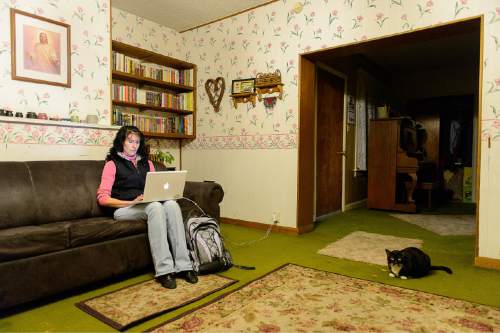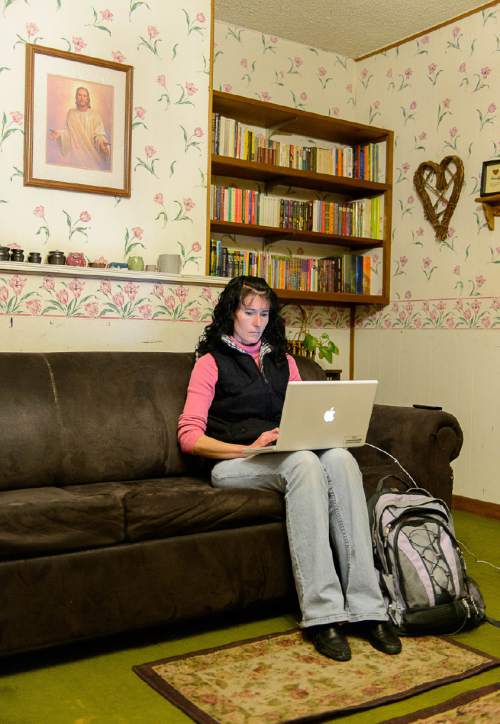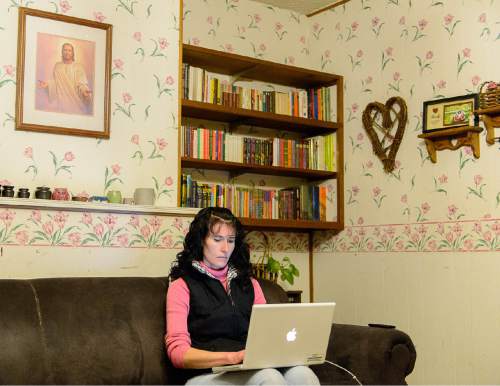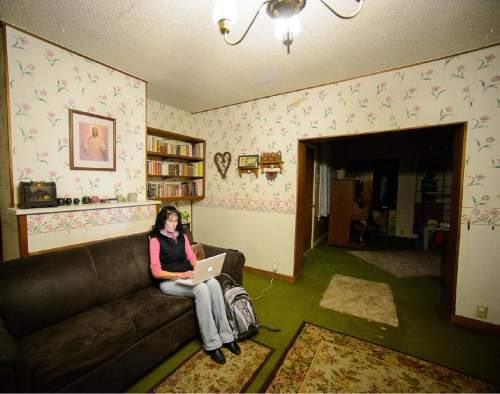This is an archived article that was published on sltrib.com in 2015, and information in the article may be outdated. It is provided only for personal research purposes and may not be reprinted.
Provo resident Wendy Hendley can't remember when she last had her teeth cleaned or examined. She is 44 and has never had her cholesterol checked.
She taps into the charity-care network for mammograms and Pap smears, but those limited preventive screenings give her scant comfort since she has no money to treat any cancer a test finds.
"I don't want to live in fear. I want to enjoy life," says Hendley, a single mother with two teenagers at home, a daughter on a Mormon mission and a son in college. "So I say a prayer every day that nothing will happen."
Hendley is just the kind of person whose story vexes the Utah Legislature.
Lawmakers would like to cover the 63,000 people who, like Hendley, don't qualify for Medicaid but can't get federal government subsidies to help pay for private insurance. The majority are working adults, and many are parents. But covering those who fall in this gap would cost an extraordinary amount of money, so legislators are looking at two other choices:
• Pinching their noses and accepting Gov. Gary Herbert's Healthy Utah plan, which goes beyond the gap to cover 32,000 more low-income Utahns who already qualify for subsidized insurance. The feds would pick up all of the tab in 2016, and most of it the next year. The governor initially proposed a three-year pilot; last week he scaled back to a two-year plan.
• Or lawmakers could accept a partial expansion that covers only the most medically frail of the poor, such as the chronically ill or those who are mentally ill or addicted, a proposal supporters call Utah Cares and critics disparage as Frail Utah. The group could include 6,000 to 10,000 Utahns.
Bills for both proposals should be heard on the Senate floor early this week, with SB164 (Healthy Utah) from Sen. Brian Shiozawa, R-Cottonwood Heights, favored to prevail over SB153 (Utah Cares) from Rep. Allen Christensen, R-North Ogden.
The fate of Medicaid expansion, then, likely will be decided in the House, where the Republican majority remains split about the best path forward with just three weeks left in the legislative session.
House Majority Leader Jim Dunnigan, R-Taylorsville, says there could be a compromise. "Between Utah Cares and Healthy Utah there's quite a bit of real estate, and I think that we can continue to have the discussion."
But, he notes, caucus Republicans also had a "robust" discussion last week on a third path: waiting until uncertainty over the future of the Affordable Care Act (Obamacare) clears and the Supreme Court weighs in on pending cases.
" 'Not now' does not mean not ever," says Dunnigan.
—
'We all need coverage' • To Mac McCormack, expanding Medicaid to all in need, not just the frailest, is the clear choice. The 63-year-old likely would fall in the medically frail group.
McCormack, a 37-year meat cutter, lived off his savings and the sales of his baseball card and coin collections after taking a medical leave several years ago. He had carpal tunnel syndrome in his arms and hands and also prostate cancer.
When his money ran out, he was homeless and lived for six years with the stress of his diagnosis. "I couldn't do anything about it."
A month after qualifying for Utah's Medicaid program in 2013, he had surgery to rid himself of the cancer. "I got lucky we were able to get mine when Medicaid kicked in," he says.
After he reached 62, McCormack began collecting a union pension and Social Security, putting him just beyond the maximum income for Medicaid. So he entered the Medicaid Spend Down program, which requires him to pay $284 a month.
Just under 280,000 Utahns get their health insurance through Medicaid. About 20,000 have medical coverage through the Spend Down program.
McCormack's harrowing experience convinces him that all should be insured.
"To me, it's a no-brainer," he says. "We all need coverage because we don't know when something's going to come up."
Whether McCormack would qualify to move into a Medicaid expansion for the frail — or "vulnerable," as Christensen prefers to call them — is unclear.
It would be up to the Utah Department of Health to decide how the program would be run and how to sort the less-needy from the most-needy.
Nate Checketts, health-reform coordinator for the department, says there are at least three models and none of them would produce quick results for a person needing medical care immediately. But then, the Affordable Care Act allows hospitals and doctors to presume patients qualify, and then sort it out after an emergency is over.
Even an airtight definition of the word "frail" cannot answer an important question, Checketts says: How many frail Utahns would show up?
"If we think we may get 10,000, we might get 5,000 or we might get 15,000," says Checketts. "Neither of those would surprise me."
Christensen says even with the uncertainty, SB153 is a stab at narrowing the gap.
Leaving some money on the table, he says, is responsible because the state has other needs besides health care.
"Is it the state's responsibility to provide everything to everyone? I say no," Christensen told his colleagues last week. "Socialized medicine is not the solution nor is it a constitutional guarantee. ... We don't have to help everyone or give them a free ride because they have individual problems."
—
"They can ... improve peoples' lives" • Shiozawa calls Utah Cares "woefully inadequate" when compared to SB164, Healthy Utah.
He and the governor last week agreed to change his bill to make Healthy Utah a two-year plan. Because the U.S. Department of Health and Human Services will pay most of the costs at first, it takes off the table the need to raise taxes or have hospitals and medical providers kick in a share.
"We won't rob another program to do this," Shiozawa says.
Lt. Gov. Spencer Cox says Herbert is trying to respond to lawmakers' concerns about the long-term sustainability of Healthy Utah.
"It's compassionate," says Cox. "It's also very fiscally conservative."
Everyone who signs up will know they're covered for two years, he says. Many lawmakers, however, don't want to offer a benefit that later may have to be pulled, a prospect Christensen calls a "cruel joke."
Cox says a working group would be formed with people from the administration and Legislature to track how Healthy Utah performs but also to lead "true" health-care reform that encourages healthy behavior and controls costs.
Rep. Dean Sanpei, R-Provo, a health-care industry executive, is all for an overhaul of health care, including moves to integrate physical and behavioral health.
But he rejects the idea of expanding Medicaid for just two years as "disruptive."
"It makes the proposal less attractive because it makes the question of sustainability worse," says Sanpei. "It means we're getting a solution that's shorter in duration.
"I really want a generational solution, and I think there's an opportunity to do something like that."
Just what that is, he says, is not yet clear.
Hendley sees Sanpei's point about a two-year plan, but would consider health care for two years better than nothing.
"There are thousands of people out there in the same situation, trying to do the best they can in their lives, raising their kids," she says.
"The reason I don't have health insurance is completely beyond my control, not to do with choices I made," she adds. "I didn't choose to get divorced, I didn't choose the income level I have right now."
Hendley worked for years as an aide in a neighborhood school and is on track to earn a master's degree next year so she can work as a school social worker.
"This is something they can do to improve peoples' lives," she says. "Preventive care is so much better than waiting until you're sick to go to the doctor."
kmoulton@sltrib.com Twitter: @KristenMoulton











